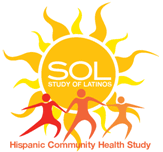| Title | Seroprevalence and Determinants of Helicobacter pylori Infection in the Hispanic Community Health Study/Study of Latinos. |
| Publication Type | Publication |
| Year | 2022 |
| Authors | Tsang SH, M Avilés-Santa L, Abnet CC, Brito MO, Daviglus ML, Wassertheil-Smoller S, Castañeda SF, Minnerath S, Talavera GA, Graubard BI, Thyagarajan B, M Camargo C |
| Journal | Clin Gastroenterol Hepatol |
| Volume | 20 |
| Issue | 3 |
| Pagination | e438-e451 |
| Date Published | 2022 Mar |
| ISSN | 1542-7714 |
| Keywords | Adolescent, Adult, Aged, Helicobacter Infections, Helicobacter pylori, Hispanic or Latino, Humans, Male, Middle Aged, Prevalence, Public Health, Risk Factors, Seroepidemiologic Studies, United States, Young Adult |
| Abstract | BACKGROUND & AIMS: Helicobacter pylori infection is the primary known risk factor for gastric cancer. Despite the global decline in H. pylori prevalence, this infection remains a major public health concern in developing areas, including Latin America. Our study aimed to determine H. pylori seroprevalence and identified its determinants among Hispanics/Latinos living in the United States (U.S.).METHODS: The Hispanic Community Health Study/Study of Latinos (HCHS/SOL) is a population-based sample of self-identified Hispanics/Latinos (n = 16,144) in four U.S. communities, aged 18 to 74 years, recruited from randomly selected households using a stratified two-stage area probability sample design based on sampling households within sampled census block groups weighted for differential response rates. Anti-H. pylori immunoglobulin G antibodies were measured by an enzyme-linked immunosorbent assay using plasma samples. We calculated adjusted seroprevalence (i.e., predicted margins) from multivariable logistic regression models.RESULTS: The overall weighted H. pylori seroprevalence was 57% among HCHS/SOL participants, with 38% and 62% seropositivity among U.S.-born and non-U.S.-born individuals, respectively. Age-adjusted prevalence varied by self-reported Hispanic/Latino background, ranging from 47% in Puerto Rican to 72% in Central American backgrounds. Adjusted H. pylori seroprevalence was higher in the following groups: older age, male sex, lower education, non-U.S. born status, smoking, greater number of missing teeth, fewer doctor visits, lower ferritin level, and hepatitis A seropositivity.CONCLUSIONS: H. pylori seroprevalence in Hispanics/Latinos remains high and differed significantly by Hispanic/Latino background. H. pylori seropositivity is strongly associated with poor socioeconomic conditions. These findings highlight the ongoing importance of this bacterial infection in the U.S. |
| DOI | 10.1016/j.cgh.2021.02.042 |
| Alternate Journal | Clin Gastroenterol Hepatol |
| PubMed ID | 33667677 |
| PubMed Central ID | PMC8410907 |
| Grant List | N01HC65236 / HL / NHLBI NIH HHS / United States N01HC65235 / HL / NHLBI NIH HHS / United States N01HC65234 / HL / NHLBI NIH HHS / United States N01HC65233 / HL / NHLBI NIH HHS / United States N01HC65237 / HL / NHLBI NIH HHS / United States |
Seroprevalence and Determinants of Helicobacter pylori Infection in the Hispanic Community Health Study/Study of Latinos.
MS#:
0880
ECI:
Yes
Manuscript Status:
Published
